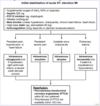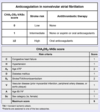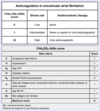Cardiovascular I Flashcards
2nd-degree, Mobitz type I heart block has a […] risk to develop into complete heart block.
2nd-degree, Mobitz type I heart block has a low risk to develop into complete heart block.
thus treatment typically is observation

2nd-degree, Mobitz type II heart block has a […] risk to develop into complete heart block.
2nd-degree, Mobitz type II heart block has a high risk to develop into complete heart block.
thus treatment typically consists of a pacemaker

Ascending aortic aneurysms are most often due to […] (due to aging) and connective tissue disorders.
Ascending aortic aneurysms are most often due to cystic medial necrosis (due to aging) and connective tissue disorders.
Ascending aortic aneurysms are most often due to cystic medial necrosis (due to aging) and […].
Ascending aortic aneurysms are most often due to cystic medial necrosis (due to aging) and connective tissue disorders.
Atrial flutter is most commonly caused by a re-entrant circuit around the […].
Atrial flutter is most commonly caused by a re-entrant circuit around the tricuspid annulus.

Atypical symptoms associated with MI are more common in […], […], and […].
Atypical symptoms associated with MI are more common in women, the elderly, and diabetics.
e.g. abdominal pain, nausea/vomiting

Beta blockers are a standard therapy in myocardial infarction but should be avoided in patients with […] or bradycardia.
Beta blockers are a standard therapy in myocardial infarction but should be avoided in patients with decompensated CHF or bradycardia.

Carotid endarterectomy is indicated in sympomatic men and women with […] - […]% stenosis.
Carotid endarterectomy is indicated in sympomatic men and women with 70 - 99% stenosis.
there is some evidence that asymptomatic patients with 80-99% stenosis may benefit from CEA as well

Cold-water immersion relieves symptoms of paraoxysmal supraventricular tachycardia by decreasing […].
Cold-water immersion relieves symptoms of paraoxysmal supraventricular tachycardia by decreasing AV node conductivity.
PSVT is most commonly due to an AV node re-entry circuit; vagal maneuvers increase parasympathetic tone, slowing AV node conductivity and terminating the AV nodal re-entry tachycardia
Cor pulmonale is impaired function of the right ventricle due to […].
Cor pulmonale is impaired function of the right ventricle due to pulmonary hypertension (pulmonary systolic pressure > 25 mmHg).
usually occurs due to chronic lung disease

Descending aortic aneurysms are usually due to underlying […].
Descending aortic aneurysms are usually due to underlying atherosclerosis.
Diagnosis of amyloidosis is confirmed using […].
Diagnosis of amyloidosis is confirmed using tissue biopsy. (e.g. abdominal fat pad)
Dobutamine improves symptoms of decompensated heart failure by increasing […].
Dobutamine improves symptoms of decompensated heart failure by increasing myocardial contractility.
leads to improved ejection fraction and reduced LV end-systolic volume
Features of severe aortic stenosis include a […]-peaking systolic murmur and a soft second heart sound.
Features of severe aortic stenosis include a late-peaking systolic murmur and a soft second heart sound.
also may have pulsus parvus et tardus; early-peaking systolic murmur is suggestive of mild to moderate AS
Features of severe aortic stenosis include a late-peaking systolic murmur and a […] second heart sound.
Features of severe aortic stenosis include a late-peaking systolic murmur and a soft second heart sound.
also may have pulsus parvus et tardus; early-peaking systolic murmur is suggestive of mild to moderate AS
First-line treatment options for beta blocker overdose include IV fluids and […].
First-line treatment options for beta blocker overdose include IV fluids and atropine.
IV fluid and atropine often do not completely reverse the cardiotoxic effects of beta blocker overdose; in such cases additional medications (e.g. glucagon) may be given as well
Flushing and pruritus secondary to niacin therapy is caused by […]-induced peripheral vasodilation.
Flushing and pruritus secondary to niacin therapy is caused by prostaglandin-induced peripheral vasodilation.
symptoms may be reduced with low-dose aspirin
How do serum levels of digoxin change in patients who begin taking amiodarone?
Increase
may lead to acute digoxin toxicity (typically GI symptoms); other anti-arrhythmics that increase digoxin levels include verapamil, quinidine, and propafenone

How do the following parameters change in an acute MI patient with hypotension, bibasilar crackles, and a systolic murmur (cardiac apex)?
Left atrial size: […]
LV end-diastolic pressure: […]
Left atrial size: No change
LV end-diastolic pressure: Increased
the patient has acute mitral regurgitation, which causes elevated LA and LV filling pressures but does not acutely result in changes in size
How do the following parameters change in LV systolic dysfunction (CHF)?
Cardiac output: […]
Systemic vascular resistance: […]
Left ventricular EDV: […]
Cardiac output: Decreased
Systemic vascular resistance: Increased
Left ventricular EDV: Increased





















